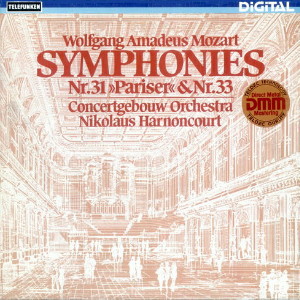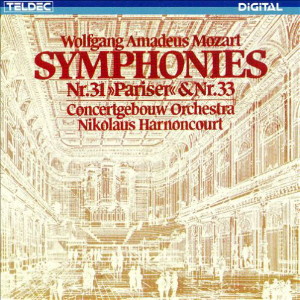 |
1 LP -
6.42817 AZ - (p) 1982
|
 |
| 1 CD -
8.42817 ZK - (c) 1983 |
|
| Wolfgang Amadeus
Mozart (1756-1791) |
|
|
|
|
|
| Symphonie Nr. 33 B-dur,
KV 319 |
26'
09" |
|
| - Allegro assai |
7' 41" |
|
- Andante
moderato
|
5'
40" |
|
| - Menuetto |
3' 08" |
|
- Finale - Allegro assai
|
9' 30" |
|
|
|
|
Symphonie
Nr. 31 D-dur, KV 297 "Pariser"
|
22'
59" |
|
| - Allegro assai |
8' 33" |
|
| - Andante |
6' 00" |
|
| - Allegro |
3' 54" |
|
| - Andante (2. Fassung) |
4' 22" |
|
|
|
|
| CONCERTGEBOUW ORCHESTRA,
AMSTERDAM |
|
| Nikolaus
Harnoncourt, Dirigent |
|
|
Luogo
e data di registrazione
|
| Concertgebouw,
Amsterdam (Olanda) - settembre 1981 |
|
Registrazione
live / studio
|
| studio |
Producer
/ Engineer
|
-
|
Prima Edizione CD
|
| Teldec
- 8.42817 ZK - (1 cd) - 49' 08" - (c)
1983 - DDD |
Prima
Edizione LP
|
Telefunken - 6.42817
AZ - (1 lp) - 49'
08"
- (p) 1982 - Digital
|
|
|
Notes
|
The two symphonies on
this recording are chronologically
quite close to each other, but are as
far apart in terms of style as they
possibly could be, while coming from
one and the same composer. The
comparison between them demonstrates
very vividly something of Mozart’s
love of experiment, but also of his
adaptability, while what repeatedly
comes up as an individual sound points
forward to the mature style of his
Viennese years.
The Paris Symphony was a commissioned
work which Mozart wrote for the
Concerts Spirituels in Paris - the
most sophisticated and renowned series
of concerts in the musical metropolis.
According to Mozart’s letters to his
father in Salzburg, who followed his
son’s progress in the great wide
musical world with expressions of
concern and admonitions, work on the
symphony was finished on l2th June
l778. On l8th June - after inadequate
rehearsals which Mozart was very
unhappy about - the premičre
came off “with a great deal of
applause”; Mozart’s letters reveal
further that the outer movements
received the violent applause, while
the Andante did not go down so well
with general public, but was highly
praised by connoisseurs. In response
to the wishes of Le
Gros, the director of the Concerts
Spirituels, Mozart replaced this
movement in the same summer with an
Andante of somewhat lighter character.
Immediately after composition, Mozart
felt the latter was the better of the
two movements. (The version normally
used now is the first, preserved in
the composer’s manuscript; the second
Andante appeared in the Paris first
edition between l782 und 1788, which
also contains detail alterations to
the first movement, probably made at
Mozart’s instigation.)
In his letter of the 12th June Mozart
had already told his father that the
work would be a success, especially
since “he hadn’t missed out the
premier coup d’archet”, which “the
asses here make a great fuss about”:
the sudden forte entrance of the whole
orchestra, usually in unison, with
which the outer movements of a
Parisian symphony had to begin, and
with which the
orchestra could demonstrate its
quality and precision. And indeed
Mozart’s symphony begins in just this
way; for the finale, he thought up an
additional witty touch: “since I’ve
heard that here all the concluding
Allegros begin like the opening ones
with all the instruments together, and
mostly in unison, I began with two
violins alone, piano, for just 8 bars
- then comes a forte all of a sudden.
So the audience all said “Sssh!”
during the piano as I expected - then
came the forte, and they all clapped!
Straight after the symphony I went
full of joy to the Palais Royal, had a
good ice-cream, prayed the rosary I
had promised, and went home” (letter
dated 3rd July).
But K. 297 is not only a Parisian work
in its inclusion or pointed avoidance
of the premier coup d’archet, but in
almost every detail: in the scoring
for a large orchestra, unusual for
Mozart, which he plays out with great
enthusiasm, in the massive tutti sound
with long drawn-out wind chords, in
the constant alternation of tutti and
concertante episodes in the strings
and woodwind, and not least in the
great climaxes and expressive triad,
signal and rustling scale motifs the
outer movements are very much in
accord with the style brought to Paris
by the Mannheimers, and developed
further above all by Gossec. - The
abundance of thematic and acoustic
ideas and the wit with which they are
played out is of course entirely
Mozart’s. All the more
astonishing, then, seems the contrast
with compositional wit and the
unfolding of splendour drawn by the
Andante, whose length and rich
modulations did not find favour with
Le Gros - a totally intimate, almost
serious piece that renounces all the
display of social life.
When Mozart wrote the
Paris Symphony, he had not composed
any symphonies for almost four years.
Even after his return to Salzburg in
January 1779 he,took his time with the
genre, and the three works written
before he finally left for Vienna
- K 318, 319 and 338 - seem like
experiments in which the horizon of
the form is measured out anew. The
most important and most personal of
the three works is certainly K. 319,
which was completed on 9th July 1779,
initially without a minuet - this was
probably first composed
for a Vienna performance in 1782. K.
319 is the complete opposite of the
Paris Symphony in every respect - the
contrast is most striking in the
scoring for small ensemble, returning
to the Salzburg orchestral sound (the
strings are supplemented only by
oboes, basscons and horns, but the
violas are divided). But previously
unheard-of chamber-musical subtleties
are wrung from this scoring, and a new
and highly personal tone corresponds
to the differentiation of the
structure, particularly in the
chromaticised melodics
and the sudden changes into the minor
that repeatedly cast a pall over the
basically happy mood. - This is even
true in the minuet, whose harmless
eight-bar sections at the beginning
and the end frame an utterly serious
contrapuntal, chromatic development.
On another level, Mozart’s handling of
the form corresponds to this posture:
in the outer movements (both sonata
movements) there is instead of the
normal development a new, strictly
contrapuntal thematic complex, which
is also contrapuntally developed, and
- at least in the first movement -
awakens religious associations,
particularly with the four-note
‘Credo’ motif later to reappear in the
“Jupiter” Symphony. In the same way,
in the otherwise quite lyrical and
melodic E flat major Andante, the
episode that leads back to the tonic
in about the middle of the movement is
brought into prominence: here it is a
contrapuntal motif which has tradition
as a Baroque formula of pathos and is
worked through first by the strings
and then by the wind section. The fact
that the whole work is permeated with
details like these, indeed that it
essentially lives and derives its
character from them, makes it an
exceptionally subtle chamber symphony;
and an exception among Mozart’s early
symphonies. It counts on a "comprehending"
audience, on connoisseurs and experts:
the exact opposite of the audience the
Paris Symphony was written for.
Ludwig
Finscher
Translation: Clive R. Williams
|
|
Nikolaus
Harnoncourt (1929-2016)
|

|

|
|